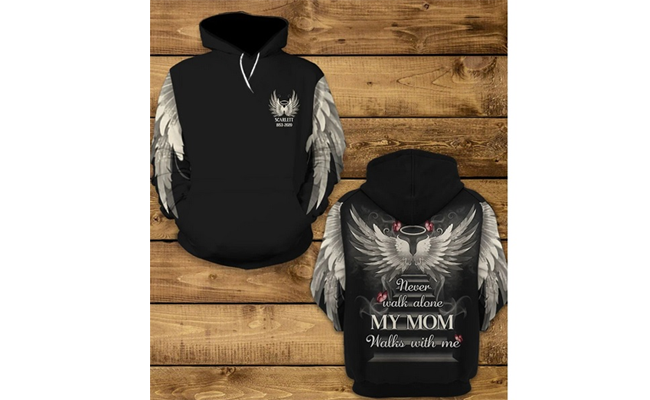
In talking to a fellow writer, I recently learned of a new trend in death wear—the memorial hoodie.
There is also the memorial T-shirt, known as the Rest in Piece shirt, or R.I.P. shirt.
“Memorial T-shirts usually have a pixelated photo of the person who has died” or “an airbrushed drawing,” says a post on the blog, Seven Ponds: Embracing End-of-Life Experience. Words such as “Rest in Peace,” “Gone Too Soon,” “In Loving Memory,” or “The Good Die Young” may accompany the picture, often written in a style reminiscent of graffiti.
“Some people might think that wearing a T-shirt to a funeral or memorial service would be disrespectful,” the post continues. “However, in many urban areas throughout the United States, memorial T-shirts are a popular way to pay tribute to loved ones who have died.”
People may wear memorial T-shirts or Rest in Peace shirts to nightclub parties honoring the person who has died, “teens will wear memorial T-shirts to school, and numerous shirts can be used to create walls of remembrance,” says the Seven Ponds post. “The shirts can be extremely colorful, have other images such as doves or crowns, and may have numerous photos of the person who died. Anything that represents the person who died can be included on a memorial T-shirt.”
While the trend may seem odd to some, cultures around the world, have often embraced diverse fashion styles as a way to pay tribute to the dead. Some time back, Digital Dying addressed one of the most common funerary fashion trends, one that has been passed down for centuries—wearing black at funerals.
“Like much we do without knowing why, it began with the Romans,” states our blog post from January 2010, Black at funerals: a two millennia-old trend, re-popularized by stuffy British women. “As all booze-guzzling college students know, their garb of choice was the toga, but some Roman togas were much more ornate than Jim Belushi’s plain white bed sheet in Animal House. The toga picta was crimson, embroidered with gold, and worn by victorious generals and emperors. The toga candida was rubbed with chalk to give it a glossy look and worn by candidates running for public office, and the toga pulla was made of brown, dark grey, or black wool and worn at funerals. The black stuck.”
“Some medieval queens broke the mold and wore white while mourning but the rigid social rules of Victorian England, when wearing as much black for as long as possible became a maniacal fad, helped define black as the mourning color of choice for the Western World,” our post continues. “Victorian women cloaked themselves in simple heavy dresses called widows weeds. Embroidery and lace were not allowed. Attached to the dress was a black veil made of stiff, dull gauze. Black bonnets were worn atop. Around their wrists, women wore jewelry made of coal, known as jet, which was, of course, black. In a locket or brooch strung from a necklace of black stones was often a lock of hair clipped from the deceased. Everything about the funeral itself was tinged in black; stationary, envelopes, notepaper, visiting cards, serving utensils, infants, and handkerchiefs. Bibles were bound with black Moroccan leather, and servants wore black armbands.”
In 2013, Digital Dying interviewed Australian designer Pia Interlandi, who has her own line of death wear called “Garments for the Grave” and is at the forefront of death-forward fashion. “The body doesn’t suddenly erupt into a zombie,” Pia told us when asked why dressing the dead was so important for the living. “My grandfather wasn’t in the body, but that doesn’t mean I didn’t care about his body. The body is still this physical entity in which you engage the person. Once you get over the initial shock of seeing someone you love dead, you become more comfortable and focus on the methodical act of dressing them. The thing with dressing is you get to touch the body, so you are immediately put into a much more intimate situation.”
This experience of dressing her grandparent’s bodies helped define her research and inspire Pia toward her unique clothing line.
Putting an actual photograph or airbrushed image of the deceased on a memorial hoodie or Rest in Peace shirt speaks to the same themes that Pia was trying to get at. It is an attempt to hold close, and remember, someone who has gone. A way to still see them right there in front of you, even though they are no longer with us.
The Seven Ponds blog post says that Rest in Peace shirts started off as more of a novelty item when they first debuted and became popular in the late 1990s and into the early 2000s, but the history of who really began the trend remains hazy. “One story places their origin on the West Coast of the United States, particularly California,” says Seven Ponds. “The trend may have been initiated by gangs as a way to memorialize fallen gang members. Another possible place of origin is New Orleans, growing from the famous jazz funeral processions.”
Now, this type of death wear has become ubiquitous in urban areas. “Memorial T-shirts are a home-grown method of remembrance for urban communities in America,” the post continues. “They represent another way to honor loved ones who have died, particularly young victims of violence. And they are another thread that helps to connect us all through the messy world that is grief.”









